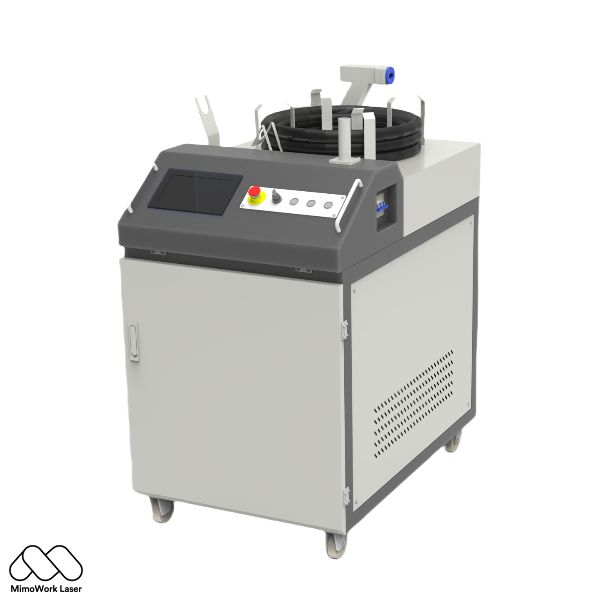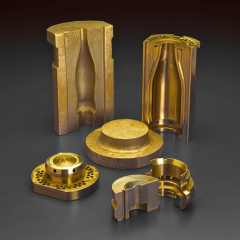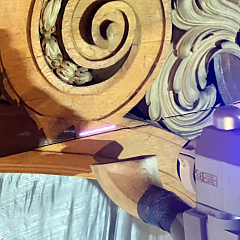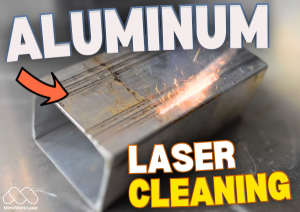Laser Cleaning Stainless Steel
Laser cleaning can be an effective method for cleaning various types of stainless steel,
But it requires a thorough understanding of the material properties
And careful control of the laser parameters
To ensure the best results
And avoid potential issues such as discoloration or surface damage.
What is Laser Cleaning?
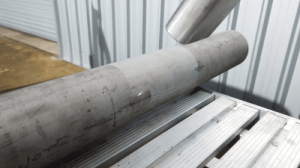
Handheld Laser Cleaning Oxide Layer off Stainless Steel Pipe
Laser cleaning is a versatile and effective technique
That utilizes high-energy laser beams
To remove contaminants, oxides, and other unwanted materials from various surfaces.
This technology has found numerous applications across different industries.
One of the key applications of laser cleaning is in the field of welding and metal fabrication.
After the welding process, the weld area often develops discoloration and oxidation,
Which can negatively impact the appearance and performance of the final product.
Laser cleaning can effectively remove these unwanted byproducts,
Preparing the surface for further processing or finishing.
How Laser Cleaning Benefits Stainless Steel Cleaning
Stainless Steel Weld Cleaning:
Stainless steel, in particular, is a material that greatly benefits from laser cleaning.
The high-energy laser beam can efficiently remove the thick, black "slag" that forms on stainless steel welds during the welding process.
This cleaning process helps to improve the overall appearance and quality of the weld, ensuring a smooth and uniform surface.
Effective, Automated, Environmental Friendly
Laser cleaning of stainless steel welds offers several advantages over traditional cleaning methods, such as chemical or mechanical cleaning.
It is a clean, automated, and consistent process that can be easily integrated into existing production lines.
The laser cleaning process can achieve cleaning speeds ranging from 1 to 1.5 meters per minute, which matches the typical welding speeds, making it a seamless integration.
Furthermore, laser cleaning eliminates the need for manual handling of chemicals or the use of abrasive tools,
Which can be time-consuming and hazardous and produce unwanted byproducts.
This results in improved workplace safety, reduced maintenance requirements, and a more efficient production process.
Can you Laser Clean Stainless Steel?
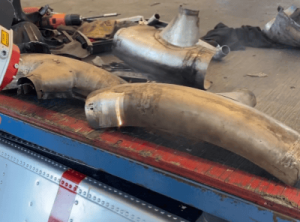
Laser Cleaning Stainless Steel Pipe
Laser cleaning is an effective method for cleaning various types of stainless steel,
But it requires careful consideration of the specific stainless steel alloy and its properties.
Laser Cleaning Austenitic Stainless Steel:
These steels have a face-centered cubic structure and are highly corrosion-resistant,
But they can work-harden to varying degrees.
Examples include the 300 series stainless steels, such as 304 and 316.
Laser Cleaning Martensitic Stainless Steel:
These steels can be hardened and tempered through heat treatment.
They are generally less tough than austenitic steels but more machinable due to their lower nickel content.
The 400 series stainless steels fall into this category.
Laser Cleaning Ferritic Stainless Steel:
This subgroup of the 400 series is heat-treatable and hardens without excessive work.
Examples include 430 stainless steel, which is often used for blades.
Laser Cleaning Stainless Steel: What to Lookout for
When laser cleaning stainless steel,
It's important to be mindful of the potential for discoloration (The formation of yellow or brown staining) or damage to the surface.
Factors such as laser power, pulse frequency, and the controlled atmosphere (e.g., nitrogen shielding gas) can all impact the quality of the cleaning process.
Careful monitoring and adjustment of the laser parameters and gas flow rates can help mitigate this problem.
Another consideration is the potential for work hardening or distortion of the stainless steel surface during the laser cleaning process.
To Achieve the Most Effective Laser Cleaning of Stainless Steel
We Can Provide the Right Settings for you
What is the most Effective Way to clean Stainless Steel?

Laser Cleaning Rust and Marks on Stainless Steel Pipe
Spoiler Alert: It's Laser Cleaning
Common Ways to Clean Stainless Steel (Although Not Effective)
One common method is using a mild detergent solution.
While this can be effective for light cleaning,
It may not be sufficient for removing stubborn rust or stains.
Another approach is applying a stainless steel cleaner,
Which can help clean smudges and grime.
However, these cleaners may not penetrate deeply enough to address more severe rust or scale buildup.
Some people also try using white vinegar or baking soda to clean stainless steel.
While these natural cleaners can be effective for removing certain types of stains,
They can also be too abrasive and potentially damage the brushed finish of the stainless steel.
In Contrast, What about Laser Cleaning?
Laser cleaning is highly precise and can target specific areas without damaging the underlying metal.
Compared to manual scrubbing or chemical cleaning, laser cleaning is also more efficient and consistent.
Eliminating the need for water or other cleaning solutions that can leave behind residues or water spots.
Furthermore, laser cleaning is a non-contact method, meaning it does not physically touch the stainless steel surface.
Laser Cleaning Stainless Steel Rust

Laser Cleaning Rust From Stainless Steel Frying Pan
Laser cleaning has become a highly effective and efficient method for removing rust and scale from stainless steel surfaces.
This non-abrasive, non-contact cleaning process offers several advantages over traditional rust removal techniques.
Overlooked Tips for Laser Cleaning Stainless Steel Rust
The Right Setting Makes all the Difference
Ensure the laser parameters (power, pulse duration, repetition rate) are optimized for the specific type and thickness of the stainless steel to avoid any damage to the underlying material.
Monitor for Consistency
Carefully monitor the cleaning process to avoid over-exposure, which can lead to discoloration or other surface defects.
Shielding Gas for Better Results
Consider the use of a shielding gas, such as nitrogen or argon, to prevent the formation of new oxides during the cleaning process.
Regularly Maintenance & Proper Safety Measures
Regularly maintain and calibrate the laser system to ensure consistent and reliable performance.
Implement proper safety measures, such as eye protection and ventilation,
to protect operators from laser radiation and any fumes or particulates generated during the cleaning process.
Applications for Laser Cleaning Stainless Steel
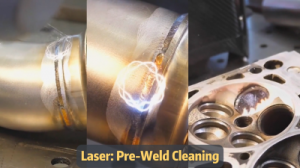
Laser Cleaning Stainless Welds
Many different types of wood can be effectively cleaned using laser technology.
The most suitable woods for laser cleaning are those that are not too dark or reflective in color.
Weld Preparation and Cleaning
Laser cleaning is highly useful for preparing and cleaning stainless steel welds.
It can effortlessly remove the thick, black slag that forms during the welding process,
Preparing the surface for subsequent finishing operations.
Laser cleaning can achieve cleaning speeds of 1-1.5 m/min
Matching common welding speeds and allowing it to be easily integrated into existing production lines.
Surface Profiling
Before applying protective coatings to fabricated stainless steel parts,
The surfaces must be clean and free of all contaminants like oil, grease, scale, and oxide layers.
Laser cleaning provides a non-abrasive,
Non-contact way to thoroughly profile and prepare these surfaces without damaging the underlying material.
Adhesive Bonding Preparation
To ensure strong, durable adhesive bonds on stainless steel,
the surface must be carefully prepared by removing oxides, grease, and other contaminants.
Laser cleaning is ideal for this application, as it can precisely modify the surface without harming the substrate.
This results in excellent bond strength and improved corrosion resistance.
Weld Residue Removal
Laser cleaning can also be used to remove residual flux, oxide materials, and thermal stains from finished stainless steel weld joints.
This helps passivate the weld seams, increasing corrosion resistance.
The adjustable wavelength and power of lasers allow for precise treatment over a wide range of material thicknesses.
Partial Decoating
Laser cleaning is effective for the partial removal of paints or coatings from stainless steel surfaces,
such as for creating Faraday cages, bond points, or electromagnetic compatibility.
The laser can precisely target the coating in the desired area without damaging the underlying substrate.
Due to the noncontinuous laser output and high peak laser power, the pulsed laser cleaner is more energy-saving and suitable for fine parts cleaning.
The adjustable pulsed laser is flexible and serviceable in rust removal, paint removal, stripping coating, and eliminating oxide and other contaminants.
Versatility Through Adjustable Power Parameter
Low Operating and Maintenance Costs
Non-Contact Cleaning Minimize Wood Damage
Different from pulse laser cleaner, the continuous wave laser cleaning machine can reach higher-power output which means higher speed and larger cleaning covering space.
That’s an ideal tool in shipbuilding, aerospace, automotive, mold, and pipeline fields due to the highly efficient and steady cleaning effect regardless of the indoor or outdoor environment.
High Power Output for Industrial Setting
Higher Efficiency For Thicker Rust & Coating
Intuitive Operating System for Point-and-Clean Experience


